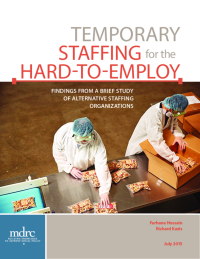Temporary Staffing for the Hard-to-Employ
Findings from a Brief Study of Alternative Staffing Organizations

The number of workers employed through temporary staffing agencies has more than doubled in the past 25 years, from 1.1 million in 1990 to about 2.8 million in 2014, and these agencies have become an increasingly important employer of low-skilled, low-wage workers. Researchers have begun to explore the potential and the reality of short-term work through staffing firms in terms of facilitating job placements for workers with barriers to employment, such as welfare recipients, people with disabilities, and workers with limited education. Evidence in this area, which is largely nonexperimental, suggests that such placements can improve workers’ employment prospects and earnings in the short term, but on average, these jobs are associated with lower earnings and less stable employment than direct-hire jobs in the long run.
Alternative staffing organizations (ASOs) use the temporary staffing business model to help hard-to-employ individuals secure work. Like conventional firms, ASOs provide staffing services to employers for a fee, but they place a greater focus on the well-being of the worker than a conventional staffing firm would. Rigorous research is lacking on the impact that ASOs produce in the lives of their workers; however, since tryout employment has become more routine, the model deserves further exploration as an employment strategy for workers with barriers. This paper presents the results of MDRC’s research on the potential of the alternative staffing sector to employ disadvantaged workers, which included visits to three ASOs to interview staff and conduct observations, as well as conversations with the Alternative Staffing Alliance, a national association for the sector.
Key Findings
-
The core of the ASO model is rapid, transitional employment that yields immediate income and work experience for disadvantaged workers, with limited supports to boost job retention. ASOs rely on partnerships with community-based organizations to recruit workers who have received some supports to be “job-ready.” Postplacement job coaching is the most common form of support provided by ASOs.
-
ASOs appear to fill a gap in workforce intermediation for low-skilled workers in regional labor markets. ASOs that participated in this research believe they are better able to meet the needs of employers for low-skilled workers because conventional staffing firms do not pay as close attention to matching candidates to the specific needs of the customer business.
-
In order to create job opportunities for the hard-to-employ and engage private employers on a large scale, ASOs have to build the capacity to run a viable, competitive business, while balancing their social mission. This includes understanding the dynamics of the local labor market and the needs of employers, as well as investments in sales and management staff with expertise in the for-profit staffing industry.
- The young and evolving ASO field could benefit from a variety of research activities. In order to participate in any evidence-building experiment and to understand their impact on workers, ASOs will need investments in strong internal systems to monitor and track data on participants, employers, and partners.







